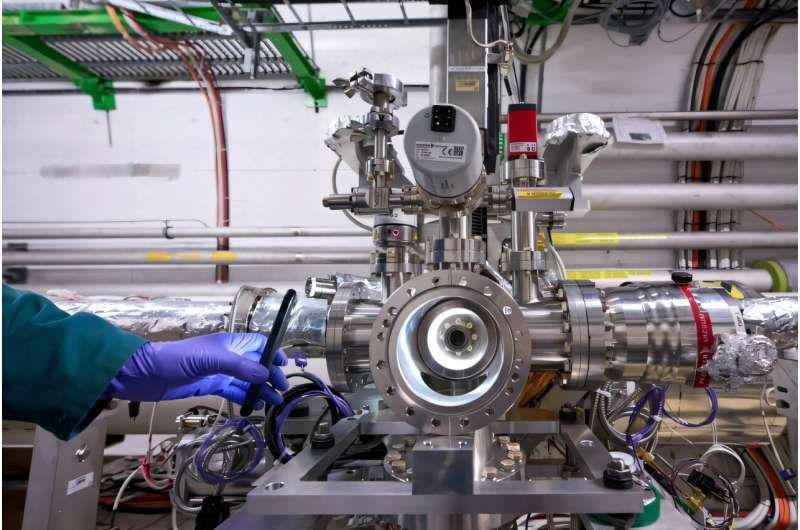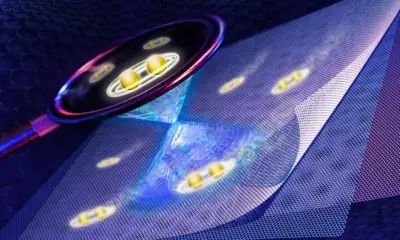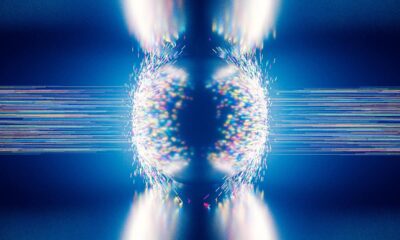Science
New Beam Monitor Launches at Large Hadron Collider

A new beam diagnostic instrument, the Beam Gas Curtain (BGC) monitor, has been successfully introduced at the Large Hadron Collider (LHC), the world’s most powerful particle accelerator. Developed by researchers from the University of Liverpool’s QUASAR Group, this innovative device is designed to measure the properties of high-energy particle beams without interfering with their operation. The BGC monitor has received approval for continuous use, anticipated to operate around 2,000 hours per year.
The concept of the BGC monitor has evolved over the past decade within the QUASAR Group, which is part of the Department of Physics and the Cockcroft Institute at the University of Liverpool. Professor Carsten P. Welsch, who has led the development for nearly 20 years, expressed his enthusiasm: “This is a tremendous achievement for our collaboration. Seeing a device that began as a concept explored by several generations of our Ph.D. students now operating at the heart of the LHC is truly inspiring.”
How the Beam Gas Curtain Works
The functionality of the BGC monitor is detailed in a paper published in Physical Review Research. The team, in collaboration with GSI and CERN, successfully conducted the first-ever full-cycle, non-invasive beam emittance measurements using this technique. The BGC operates by generating an ultra-thin, supersonic sheet of neon gas, which forms a “curtain” that interacts with the proton or lead ion beam circulating in the accelerator.
This interaction produces faint flashes of fluorescence light, which are captured by an advanced optical system. This allows researchers to gather precise information about the beam’s size and quality throughout the entire acceleration cycle. Unlike existing diagnostic tools that require calibration time or interrupt operations, the BGC monitor can continuously analyze the beam’s profile from its initial injection at 450 GeV up to the LHC’s maximum energy of 6.8 TeV, all while physics experiments are ongoing.
Testing and Future Implications
Prior to its installation at CERN, the BGC system underwent extensive testing at the Cockcroft Institute. Its performance has exceeded expectations, providing high-precision, non-invasive measurements for both proton and heavy-ion beams. The published research indicates that the results align closely with independent diagnostics at the LHC, such as the Beam Synchrotron Radiation Telescope and emittance scans conducted during the ATLAS and CMS experiments.
Dr. Hao Zhang, Deputy Group Leader in the QUASAR Group, remarked on the significance of the monitor’s integration: “Having our monitor now fully integrated into daily LHC operations is a real ‘wow’ moment. It is the culmination of years of development, from vacuum compatibility studies and optical design to software integration and on-site commissioning.”
Now that the BGC is officially part of the LHC’s beam instrumentation, it opens the door for similar systems to be implemented in other major research facilities. These include the European Spallation Source in Sweden and the Electron Ion Collider in the United States, as well as potential applications in medical accelerators.
Professor Welsch added, “This achievement shows how university-based innovation can directly shape the tools that keep the world’s largest scientific instruments running. It is a very proud moment for Liverpool and for all the students and researchers who contributed to this remarkable journey.”
For further details, see the paper by O. Sedlacek et al., titled “Full-cycle, non-invasive emittance monitoring with the beam gas curtain monitor at the LHC,” published in Physical Review Research (2025). DOI: 10.1103/5ggy-f8lm.
-

 Entertainment3 months ago
Entertainment3 months agoAnn Ming Reflects on ITV’s ‘I Fought the Law’ Drama
-

 Entertainment4 months ago
Entertainment4 months agoKate Garraway Sells £2 Million Home Amid Financial Struggles
-

 Health2 months ago
Health2 months agoKatie Price Faces New Health Concerns After Cancer Symptoms Resurface
-

 Entertainment3 months ago
Entertainment3 months agoCoronation Street’s Carl Webster Faces Trouble with New Affairs
-

 Entertainment2 months ago
Entertainment2 months agoWhere is Tinder Swindler Simon Leviev? Latest Updates Revealed
-

 Entertainment4 months ago
Entertainment4 months agoMarkiplier Addresses AI Controversy During Livestream Response
-

 Science4 weeks ago
Science4 weeks agoBrian Cox Addresses Claims of Alien Probe in 3I/ATLAS Discovery
-

 Entertainment4 months ago
Entertainment4 months agoKim Cattrall Posts Cryptic Message After HBO’s Sequel Cancellation
-

 Entertainment2 months ago
Entertainment2 months agoOlivia Attwood Opens Up About Fallout with Former Best Friend
-

 Entertainment3 months ago
Entertainment3 months agoMasterChef Faces Turmoil as Tom Kerridge Withdraws from Hosting Role
-

 Entertainment4 months ago
Entertainment4 months agoSpeculation Surrounds Home and Away as Cast Departures Mount
-

 World2 months ago
World2 months agoCole Palmer’s Mysterious Message to Kobbie Mainoo Sparks Speculation















